4th Order Point Mass (Longitudinal)
Calculate fourth-order point mass
Libraries:
Aerospace Blockset /
Equations of Motion /
Point Mass
Description
The 4th Order Point Mass (Longitudinal) block performs the calculations for the translational motion of a single point mass or multiple point masses. For more information on the system for the translational motion of a single point mass or multiple mass, see Algorithms.
The 4th Order Point Mass (Longitudinal) block port labels change based on the input and output units selected from the Units list.
Limitations
The flat Earth reference frame is considered inertial, an approximation that allows the forces due to the Earth's motion relative to the “fixed stars” to be neglected.
Ports
Input
Output
Parameters
Algorithms

The translational motions of the point mass [XEastXUp]T are functions of airspeed (V) and flight path angle (γ),
where the applied forces [FxFz]T are in a system defined as follows: x-axis is in the direction of vehicle velocity relative to air, z-axis is upward, and y-axis completes the right-handed frame. The mass of the body m is assumed constant.
Extended Capabilities
Version History
Introduced before R2006a
See Also
Simple Variable Mass 3DOF (Body Axes) | Custom Variable Mass 3DOF (Wind Axes) | 4th Order Point Mass Forces (Longitudinal) | 3DOF (Body Axes) | 3DOF (Wind Axes) | 6th Order Point Mass (Coordinated Flight) | Custom Variable Mass 3DOF (Body Axes) | 6th Order Point Mass Forces (Coordinated Flight) | Simple Variable Mass 3DOF (Wind Axes)
